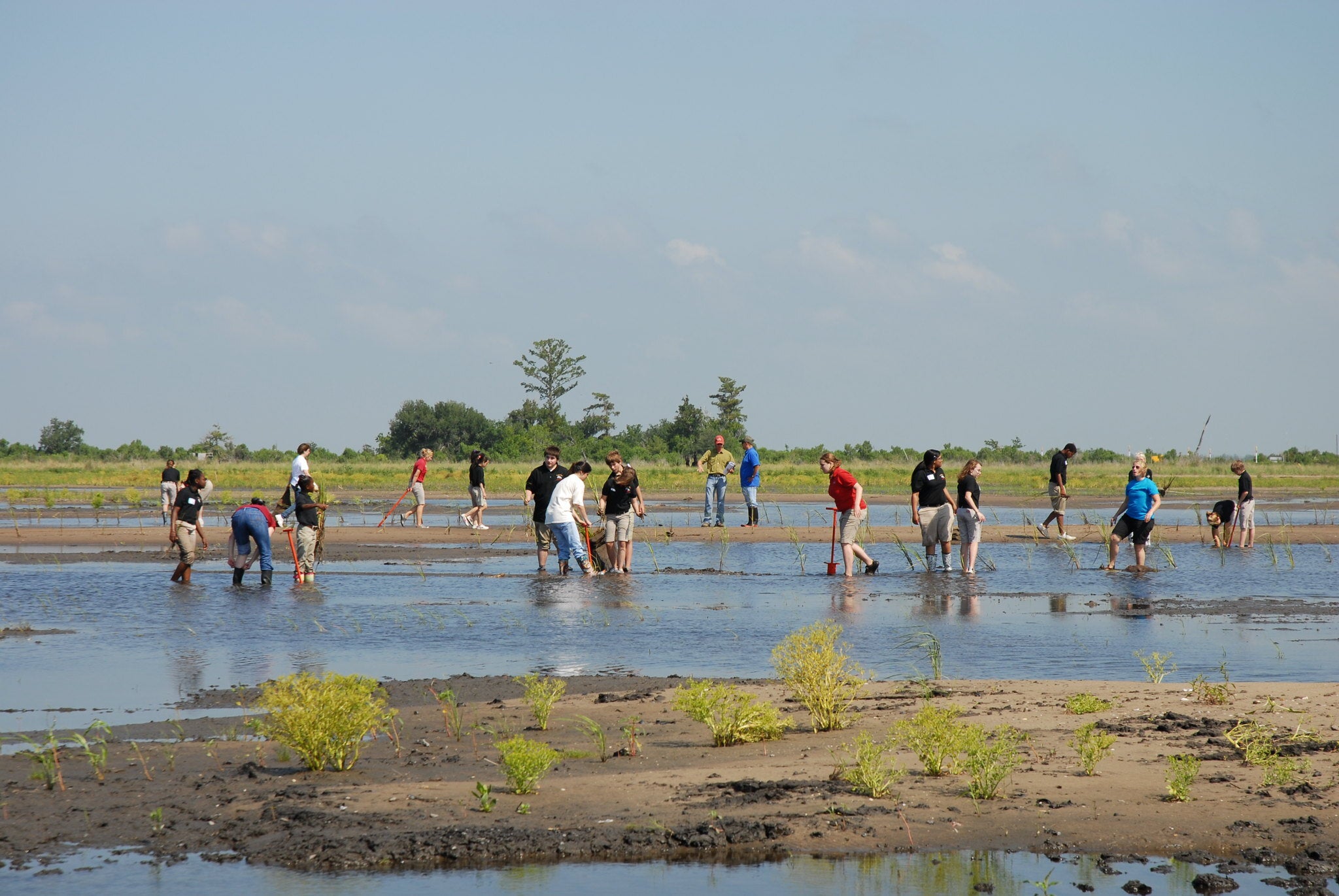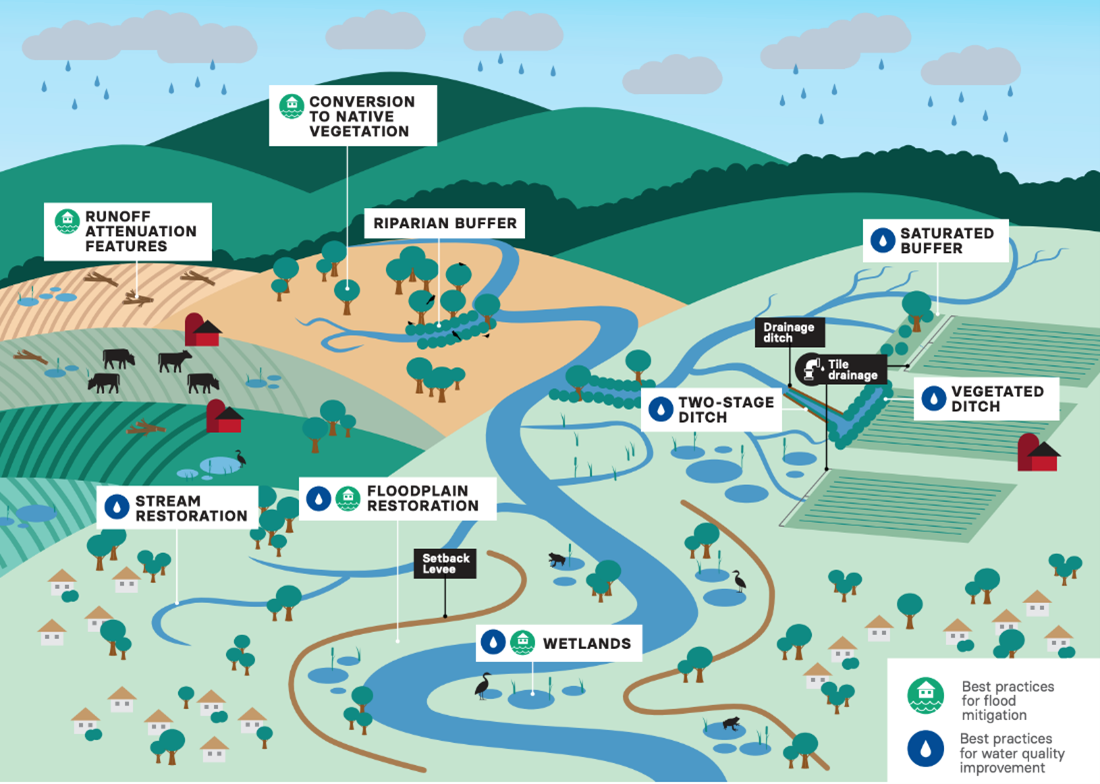
Natural infrastructure can provide protective barriers to reduce flood risk while also offering community green space and supporting green jobs. Louisiana GOHSEP, CC BY SA 2.0.
Authors: Vincent Gauthier (EDF), Tee Thomas (Quantified Ventures)
The Bipartisan Infrastructure Law will invest more than $44 billion in the Clean Water and Drinking Water State Revolving Funds, or SRFs, presenting a tremendous opportunity to finance natural infrastructure solutions that can improve water quality and protect communities against flooding. While natural infrastructure can be a cost-effective way to improve water quality and reduce flood risk, these projects have historically been difficult to finance through SRFs due to a lack of consistent repayment streams.
EDF and Quantified Ventures recently published a report that identified five replicable repayment streams that communities and conservation groups can use to access SRF financing for natural infrastructure such as wetlands, floodplain restoration, and riparian buffers. These repayment streams include stormwater utility fees, source water protection fees, and environmental markets.
This month EDF and Quantified Ventures went on the road to meet conservation finance experts and SRF leaders at the Conservation Finance Roundtable and the Council of Infrastructure Finance Authorities SRF workshop to share these repayment streams, learn more about the barriers that hold back SRF financing for natural infrastructure, and identify opportunities to address these challenges.
Here are three takeaways from these conversations:
1. SRFs have financed some natural infrastructure projects, but a slim project pipeline has kept them from doing more.
While some states have successfully financed natural infrastructure projects and created programs that specifically support upstream agriculture best management practices, the pipeline of financeable natural infrastructure projects has remained slim. This has created an endless loop in which SRF programs don’t dedicate resources for natural infrastructure projects because of a lack of demand and most conservation groups don’t develop financeable projects because they don’t think the SRFs can effectively finance their projects. In speaking with SRF staff from across the country, we learned that they have strong interest and mission alignment with natural infrastructure projects, but cannot dedicate the resources to adjust their programs to support natural infrastructure projects if they don’t see sufficient demand. Replicating repayment streams identified in EDF and Quantified Venture’s recent report, like source water protection fees, can help break this endless loop. Furthermore, since water utilities face resource and capacity challenges, the more natural projects can align with municipal water or recreation goals, the more likely it is that these projects can find their way to an SRF opportunity.
2. SRFs seem like a black box to many conservation and watershed organizations.
We learned from conservation finance experts that SRF programs can seem complicated; applicants must navigate EPA eligibilities, state rules, and complex requirements to successfully receive a low-cost SRF loan. Most conservation and watershed organizations do not have the expertise or capacity to wade through this process and bring projects that can be successfully financed to fruition. To help address this challenge, Quantified Ventures has created an SRF Academy to train conservation and watershed organization staff on the SRF program, the application process, and how to successfully receive financing for natural infrastructure projects.
3. Increasing the SRFs flexibility can help more organizations’ natural infrastructure projects access the program.
Another opportunity is to increase the flexibility of SRF programs to better service natural infrastructure projects. For example, changing the enabling SRF legislation in states to allow SRFs to lend to private borrowers, like land trusts, can increase the number of financeable natural infrastructure projects. SRFs can also provide additional subsidies for natural infrastructure projects to catalyze innovation and pilot novel repayment streams for these projects. Additionally, structuring financing to be quickly accessible for land conservation or restoration work or creating an interim financing mechanism can support natural infrastructure projects. To support these changes, conservation organizations must work with the state agencies managing the SRFs, state legislators, agriculture stakeholders, and communities. They must also dedicate resources for engaging throughout the SRF planning and public comment process to provide actionable input to the SRFs at the right times.
At our recent speaking engagements, we were heartened to find that many states are largely ready and willing to collaborate on ways to create a pipeline of natural infrastructure projects. This signals to communities, conservation organizations, and watershed groups that by collaboratively building the pipeline of natural infrastructure projects with robust repayment streams, they can leverage SRFs to invest in the natural infrastructure solutions they support.
Millions of dollars in federal funds will be disbursed through the SRFs in the coming years, and it will be pivotal to grow the pipeline of financeable natural infrastructure projects, train conservation and watershed groups to successfully apply to the SRF, and increase the flexibility of the SRF to enable natural infrastructure projects to deliver water quality and flood reduction solutions at scale.











